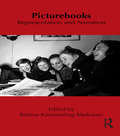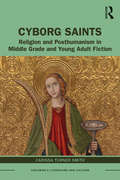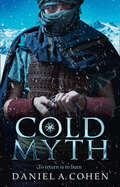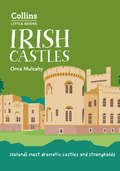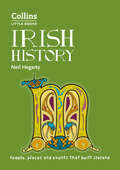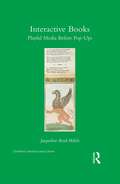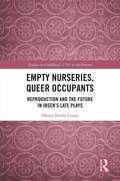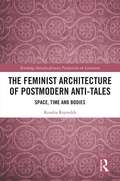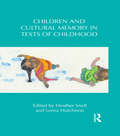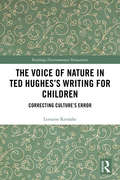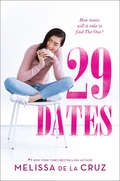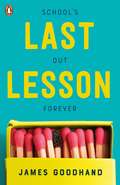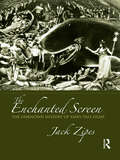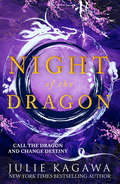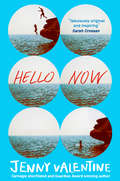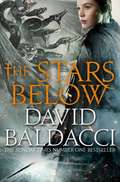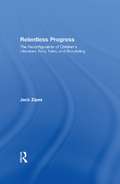- Table View
- List View
Picturebooks: Representation and Narration (Children's Literature and Culture)
by Bettina Kümmerling-MeibauerThis volume discusses the aesthetic and cognitive challenges of modern picturebooks from different countries, such as Denmark, France, Germany, Norway, Spain, Sweden, United Kingdom, and USA. The overarching issue concerns the mutual relationship between representation and narration by means of the picturebooks’ multimodal character. Moreover, this volume includes the main lines of debate and approaches to picturebooks by international leading researchers in the field. Topics covered are the impact of paratexts and interpictorial allusions, the relationship between artists’ books, crossover picturebooks, and picturebooks for adults, the narrative defiance of wordless picturebooks, the representation of emotions in images and text, and the depiction of hybrid characters in picturebooks. The enlargement of the picturebook corpus beyond an Anglo-American picturebook canon opens up new horizons and highlights the diverging styles and genre shifts in modern picturebooks. This tendency also demonstrates the influence of specific authors and illustrators on the appreciation of the picturebook genre, as in the case of Astrid Lindgren’s picturebooks and the picturebooks created by renowned illustrators, such as Anthony Browne, Wolf Erlbruch, Stian Hole, and Bruno Munari. This book will be the definite contribution to contemporary picturebook research for many years to come.
Cyborg Saints: Religion and Posthumanism in Middle Grade and Young Adult Fiction (Children's Literature and Culture)
by Carissa Turner SmithSaints are currently undergoing a resurrection in middle grade and young adult fiction, as recent prominent novels by Socorro Acioli, Julie Berry, Adam Gidwitz, Rachel Hartman, Merrie Haskell, Gene Luen Yang, and others demonstrate. Cyborg Saints: Religion and Posthumanism in Middle Grade and Young Adult Fiction makes the radical claim that these holy medieval figures are actually the new cyborgs in that they dethrone the autonomous subject of humanist modernity. While young people navigate political and personal forces, as well as technologies, that threaten to fragment and thingify them, saints show that agency is still possible outside of the humanist construct of subjectivity. The saints of these neomedievalist novels, through living a life vulnerable to the other, attain a distributed agency that accomplishes miracles through bodies and places and things (relics, icons, pilgrimage sites, and ultimately the hagiographic text and its reader) spread across time. Cyborg Saints analyzes MG and YA fiction through the triple lens of posthumanism, neomedievalism, and postsecularism. Cyborg Saints charts new ground in joining religion and posthumanism to represent the creativity and diversity of young people’s fiction.
Cyborg Saints: Religion and Posthumanism in Middle Grade and Young Adult Fiction (Children's Literature and Culture)
by Carissa Turner SmithSaints are currently undergoing a resurrection in middle grade and young adult fiction, as recent prominent novels by Socorro Acioli, Julie Berry, Adam Gidwitz, Rachel Hartman, Merrie Haskell, Gene Luen Yang, and others demonstrate. Cyborg Saints: Religion and Posthumanism in Middle Grade and Young Adult Fiction makes the radical claim that these holy medieval figures are actually the new cyborgs in that they dethrone the autonomous subject of humanist modernity. While young people navigate political and personal forces, as well as technologies, that threaten to fragment and thingify them, saints show that agency is still possible outside of the humanist construct of subjectivity. The saints of these neomedievalist novels, through living a life vulnerable to the other, attain a distributed agency that accomplishes miracles through bodies and places and things (relics, icons, pilgrimage sites, and ultimately the hagiographic text and its reader) spread across time. Cyborg Saints analyzes MG and YA fiction through the triple lens of posthumanism, neomedievalism, and postsecularism. Cyborg Saints charts new ground in joining religion and posthumanism to represent the creativity and diversity of young people’s fiction.
Coldmyth (The Coldmaker Saga #3)
by Daniel A. CohenCOLDMYTH is book 3 in the Coldmaker series and the final book in the epic new trilogy by modern master Daniel A. Cohen.
Irish Castles: Ireland's Most Dramatic Castles And Strongholds (Collins Little Books)
by Orna MulcahyA handy guide to around 140 of Ireland’s most dramatic castles and strongholds, all of which are open to the public, with structures from across the whole island of Ireland. A handy 8-page map of all locations featured is included.
Irish History: People, Places And Events That Built A Country (Collins Little Books)
by Neil HegartyFrom mesolithic Ireland to the peace process, this little book covers all of the main historical and cultural events, places and figures in Irish history. A must for all lovers of Ireland and the Irish.
Interactive Books: Playful Media before Pop-Ups (Children's Literature and Culture)
by Jacqueline Reid-WalshMovable books are an innovative area of children’s publishing. Commonly equated with spectacular pop-ups, movable books have a little-known history as interactive, narrative media. Since they are hybrid artifacts consisting of words, images and movable components, they cross the borders between story, toy, and game. Interactive Books is a historical and comparative study of early movable books in relation to the children who engage with them. Jacqueline Reid-Walsh focuses on the period movable books became connected with children from the mid-17th to the early-19th centuries. In particular, she examines turn-up books, paper doll books, and related hybrid experiments like toy theaters and paignion (or domestic play set) produced between 1650 and 1830. Despite being popular in their own time, these artifacts are little known today. This study draws attention to a gap in our knowledge of children’s print culture by showing how these artifacts are important in their own right. Reid-Walsh combines archival research with children’s literature studies, book history, and juvenilia studies. By examining commercially produced and homemade examples, she explores the interrelations among children, interactive media, and historical participatory culture. By drawing on both Enlightenment thinkers and contemporary digital media theorists Interactive Books enables us to think critically about children’s media texts paper and digital, past and present.
Interactive Books: Playful Media before Pop-Ups (Children's Literature and Culture)
by Jacqueline Reid-WalshMovable books are an innovative area of children’s publishing. Commonly equated with spectacular pop-ups, movable books have a little-known history as interactive, narrative media. Since they are hybrid artifacts consisting of words, images and movable components, they cross the borders between story, toy, and game. Interactive Books is a historical and comparative study of early movable books in relation to the children who engage with them. Jacqueline Reid-Walsh focuses on the period movable books became connected with children from the mid-17th to the early-19th centuries. In particular, she examines turn-up books, paper doll books, and related hybrid experiments like toy theaters and paignion (or domestic play set) produced between 1650 and 1830. Despite being popular in their own time, these artifacts are little known today. This study draws attention to a gap in our knowledge of children’s print culture by showing how these artifacts are important in their own right. Reid-Walsh combines archival research with children’s literature studies, book history, and juvenilia studies. By examining commercially produced and homemade examples, she explores the interrelations among children, interactive media, and historical participatory culture. By drawing on both Enlightenment thinkers and contemporary digital media theorists Interactive Books enables us to think critically about children’s media texts paper and digital, past and present.
Empty Nurseries, Queer Occupants: Reproduction and the Future in Ibsen’s Late Plays (Studies in Childhood, 1700 to the Present)
by Olivia Noble GunnWho is the proper occupant of the nursery? The obvious answer is the child, and not an archive, a seductive troll-princess, or poor fosterlings. Nevertheless, characters in Hedda Gabler, The Master Builder, and Little Eyolf intend to host these improper occupants in their children’s rooms. Dr. Gunn calls these dramas ‘the empty nursery plays’ because they all describe rooms intended for offspring, as well as characters’ plans for refilling that space. One might expect nurseries to provide an ideal setting for a realist playwright to dramatize contemporary problems. Rather than mattering to Ibsen in terms of naturalist detail or explicit social critique, however, they are reserved for the maintenance of characters’ fears and expectations concerning the future. Empty Nurseries, Queer Occupants intervenes in scholarly debates in child studies by arguing that the empty bourgeois nursery is a better symbol for innocence than the child. Here, ‘emptiness’ refers to the common construction of the child as blank and latent. In Ibsen, the child is also doomed or deceased, and thus essentially absent, but nurseries persist as spaces of memorialization and potential alike. Nurseries also gesture toward the domains of childhood and women’s labor, from birth to domestic service. ‘Bourgeois nursery’ points to the classed construction of innocence and to the more materialist aspects of this book, which inform our understanding of domesticity and family in the West and uncover a set of reproductive connotations broader than ‘the innocent child’ can convey.
The Feminist Architecture of Postmodern Anti-Tales: Space, Time, and Bodies (Routledge Interdisciplinary Perspectives on Literature)
by Kendra ReynoldsThis monograph aims to counter the assumption that the anti-tale is a ‘subversive twin’ or dark side of the fairy tale coin, instead it argues that the anti-tale is a genre rich in complexity and radical potential that fundamentally challenges the damaging ideologies and socializing influence of fairy tales. The Feminist Architecture of Postmodern Anti-Tales: Space, Time and Bodies highlights how anti-tales take up timely debates about revising old structures, opening our minds up to a broader spectrum of experience or ways of viewing the world and its inhabitants. They show us alternative architectures for the future by deconstructing established spatio-temporal laws and structures, as well as limited ideas surrounding the body, and ultimately liberate us from the shackles of a single-minded and simplistic masculine reality currently upheld by dominant social forces and patriarchal fairy tales themselves. It is only when these masculine fairy tales and social architectures are deconstructed that new, more inclusive feminine realities and futures can be brought into being.
Empty Nurseries, Queer Occupants: Reproduction and the Future in Ibsen’s Late Plays (Studies in Childhood, 1700 to the Present)
by Olivia Noble GunnWho is the proper occupant of the nursery? The obvious answer is the child, and not an archive, a seductive troll-princess, or poor fosterlings. Nevertheless, characters in Hedda Gabler, The Master Builder, and Little Eyolf intend to host these improper occupants in their children’s rooms. Dr. Gunn calls these dramas ‘the empty nursery plays’ because they all describe rooms intended for offspring, as well as characters’ plans for refilling that space. One might expect nurseries to provide an ideal setting for a realist playwright to dramatize contemporary problems. Rather than mattering to Ibsen in terms of naturalist detail or explicit social critique, however, they are reserved for the maintenance of characters’ fears and expectations concerning the future. Empty Nurseries, Queer Occupants intervenes in scholarly debates in child studies by arguing that the empty bourgeois nursery is a better symbol for innocence than the child. Here, ‘emptiness’ refers to the common construction of the child as blank and latent. In Ibsen, the child is also doomed or deceased, and thus essentially absent, but nurseries persist as spaces of memorialization and potential alike. Nurseries also gesture toward the domains of childhood and women’s labor, from birth to domestic service. ‘Bourgeois nursery’ points to the classed construction of innocence and to the more materialist aspects of this book, which inform our understanding of domesticity and family in the West and uncover a set of reproductive connotations broader than ‘the innocent child’ can convey.
The Feminist Architecture of Postmodern Anti-Tales: Space, Time, and Bodies (Routledge Interdisciplinary Perspectives on Literature)
by Kendra ReynoldsThis monograph aims to counter the assumption that the anti-tale is a ‘subversive twin’ or dark side of the fairy tale coin, instead it argues that the anti-tale is a genre rich in complexity and radical potential that fundamentally challenges the damaging ideologies and socializing influence of fairy tales. The Feminist Architecture of Postmodern Anti-Tales: Space, Time and Bodies highlights how anti-tales take up timely debates about revising old structures, opening our minds up to a broader spectrum of experience or ways of viewing the world and its inhabitants. They show us alternative architectures for the future by deconstructing established spatio-temporal laws and structures, as well as limited ideas surrounding the body, and ultimately liberate us from the shackles of a single-minded and simplistic masculine reality currently upheld by dominant social forces and patriarchal fairy tales themselves. It is only when these masculine fairy tales and social architectures are deconstructed that new, more inclusive feminine realities and futures can be brought into being.
Children and Cultural Memory in Texts of Childhood (Children's Literature and Culture)
by Heather Snell Lorna HutchisonThe essays in this collection address the relationship between children and cultural memory in texts both for and about young people. The collection overall is concerned with how cultural memory is shaped, contested, forgotten, recovered, and (re)circulated, sometimes in opposition to dominant national narratives, and often for the benefit of young readers who are assumed not to possess any prior cultural memory. From the innovative development of school libraries in the 1920s to the role of utopianism in fixing cultural memory for teen readers, it provides a critical look into children and ideologies of childhood as they are represented in a broad spectrum of texts, including film, poetry, literature, and architecture from Canada, the United States, Japan, Germany, Britain, India, and Spain. These cultural forms collaborate to shape ideas and values, in turn contributing to dominant discourses about national and global citizenship. The essays included in the collection imply that childhood is an oft-imagined idealist construction based in large part on participation, identity, and perception; childhood is invisible and tangible, exciting and intriguing, and at times elusive even as cultural and literary artifacts recreate it. Children and Cultural Memory in Texts of Childhood is a valuable resource for scholars of children’s literature and culture, readers interested in childhood and ideology, and those working in the fields of diaspora and postcolonial studies.
Children and Cultural Memory in Texts of Childhood: Children And Cultural Memory In Texts Of Childhood (Children's Literature and Culture)
by Heather Snell Lorna HutchisonThe essays in this collection address the relationship between children and cultural memory in texts both for and about young people. The collection overall is concerned with how cultural memory is shaped, contested, forgotten, recovered, and (re)circulated, sometimes in opposition to dominant national narratives, and often for the benefit of young readers who are assumed not to possess any prior cultural memory. From the innovative development of school libraries in the 1920s to the role of utopianism in fixing cultural memory for teen readers, it provides a critical look into children and ideologies of childhood as they are represented in a broad spectrum of texts, including film, poetry, literature, and architecture from Canada, the United States, Japan, Germany, Britain, India, and Spain. These cultural forms collaborate to shape ideas and values, in turn contributing to dominant discourses about national and global citizenship. The essays included in the collection imply that childhood is an oft-imagined idealist construction based in large part on participation, identity, and perception; childhood is invisible and tangible, exciting and intriguing, and at times elusive even as cultural and literary artifacts recreate it. Children and Cultural Memory in Texts of Childhood is a valuable resource for scholars of children’s literature and culture, readers interested in childhood and ideology, and those working in the fields of diaspora and postcolonial studies.
The Voice of Nature in Ted Hughes’s Writing for Children: Correcting Culture's Error (Routledge Environmental Humanities)
by Lorraine KerslakeDespite the fame Ted Hughes’s poetry has achieved, there has been surprisingly little critical writing on his children’s literature. This book identifies the importance of Hughes’s children’s writing from an ecocritical perspective and argues that the healing function that Hughes ascribes to nature in his children’s literature is closely linked to the development of his own sense of environmental responsibility. This book will be the first sustained examination of Hughes’s greening in relation to his writing for children, providing a detailed reading of Hughes’s children’s literature through his poetry, prose and drama as well as his critical essays and letters. In addition, it also explores how Hughes’s children’s writing is a window to the poet’s own emotional struggles, as well as his environmental consciousness and concern to reconnect a society that has become alienated from nature. This book will be of great interest to not only those studying Ted Hughes, but also students and scholars of environment and literature, ecocriticism, children’s literature and twentieth-century literature.
The Voice of Nature in Ted Hughes’s Writing for Children: Correcting Culture's Error (Routledge Environmental Humanities)
by Lorraine KerslakeDespite the fame Ted Hughes’s poetry has achieved, there has been surprisingly little critical writing on his children’s literature. This book identifies the importance of Hughes’s children’s writing from an ecocritical perspective and argues that the healing function that Hughes ascribes to nature in his children’s literature is closely linked to the development of his own sense of environmental responsibility. This book will be the first sustained examination of Hughes’s greening in relation to his writing for children, providing a detailed reading of Hughes’s children’s literature through his poetry, prose and drama as well as his critical essays and letters. In addition, it also explores how Hughes’s children’s writing is a window to the poet’s own emotional struggles, as well as his environmental consciousness and concern to reconnect a society that has become alienated from nature. This book will be of great interest to not only those studying Ted Hughes, but also students and scholars of environment and literature, ecocriticism, children’s literature and twentieth-century literature.
29 Dates (Hq Young Adult Ebook Ser.)
by Melissa de la Cruz‘A heartwarming, sparkling romantic comedy… Completely unputdownable!’ Sandhya Menon, New York Times bestselling author of When Dimple Met Rishi How many dates will it take to find The One?
Last Lesson
by James GoodhandLast year, Ollie Morcombe was a star pupil, popular and a gifted musician.Then, after the accident, everything changed. Now he's an outcast, a prime target of the school bullies who have made his life a living hell.Today - the last day of the school year - he's brought those bullies a gift. A homemade pipe bomb.What has driven a model student to plan an unspeakable revenge? And with the clock ticking down to home time, what can anybody do to stop him?
The Enchanted Screen: The Unknown History of Fairy-Tale Films
by Jack ZipesThe Enchanted Screen: The Unknown History of Fairy-Tale Films offers readers a long overdue, comprehensive look at the rich history of fairy tales and their influence on film, complete with the inclusion of an extensive filmography compiled by the author. With this book, Jack Zipes not only looks at the extensive, illustrious life of fairy tales and cinema, but he also reminds us that, decades before Walt Disney made his mark on the genre, fairy tales were central to the birth of cinema as a medium, as they offered cheap, copyright-free material that could easily engage audiences not only though their familiarity but also through their dazzling special effects. Since the story of fairy tales on film stretches far beyond Disney, this book, therefore, discusses a broad range of films silent, English and non-English, animation, live-action, puppetry, woodcut, montage (Jim Henson), cartoon, and digital. Zipes, thus, gives his readers an in depth look into the special relationship between fairy tales and cinema, and guides us through this vast array of films by tracing the adaptations of major fairy tales like "Little Red Riding Hood," "Cinderella," "Snow White," "Peter Pan," and many more, from their earliest cinematic appearances to today. Full of insight into some of our most beloved films and stories, and boldly illustrated with numerous film stills, The Enchanted Screen, is essential reading for film buffs and fans of the fairy tale alike.
The Enchanted Screen: The Unknown History of Fairy-Tale Films
by Jack ZipesThe Enchanted Screen: The Unknown History of Fairy-Tale Films offers readers a long overdue, comprehensive look at the rich history of fairy tales and their influence on film, complete with the inclusion of an extensive filmography compiled by the author. With this book, Jack Zipes not only looks at the extensive, illustrious life of fairy tales and cinema, but he also reminds us that, decades before Walt Disney made his mark on the genre, fairy tales were central to the birth of cinema as a medium, as they offered cheap, copyright-free material that could easily engage audiences not only though their familiarity but also through their dazzling special effects. Since the story of fairy tales on film stretches far beyond Disney, this book, therefore, discusses a broad range of films silent, English and non-English, animation, live-action, puppetry, woodcut, montage (Jim Henson), cartoon, and digital. Zipes, thus, gives his readers an in depth look into the special relationship between fairy tales and cinema, and guides us through this vast array of films by tracing the adaptations of major fairy tales like "Little Red Riding Hood," "Cinderella," "Snow White," "Peter Pan," and many more, from their earliest cinematic appearances to today. Full of insight into some of our most beloved films and stories, and boldly illustrated with numerous film stills, The Enchanted Screen, is essential reading for film buffs and fans of the fairy tale alike.
Night Of The Dragon (Shadow of the Fox #3)
by Julie KagawaEvil and hope clash and burn in the epic and shocking conclusion to the Shadow of the Fox trilogy. ‘One of my all-time favourite fantasy novels!’ Ellen Oh, author of the Prophecy and Spirit Hunters series, on Shadow of the Fox
Hello Now
by Jenny ValentineA beautifully moving, exquisite and utterly original love story from Carnegie-shortlisted author Jenny Valentine – for 12+ girls, boys, and everything in between.
The Stars Below (Vega Jane #4)
by David BaldacciThis is it. Vega Jane has tried to outrun, outsmart, and outlast her enemy, but the showdown she has dreaded is finally here. Her ragtag crew must take a stand against a fully trained army, knowing the odds are impossible, knowing each of them could die for nothing.But when evil comes, heroes stand to meet it. When injustice appears, the only choice is to stand and fight.David Baldacci's The Stars Below is the fourth novel and the epic conclusion to his Vega Jane series.
Relentless Progress: The Reconfiguration of Children's Literature, Fairy Tales, and Storytelling
by Jack ZipesCan fairy tales subvert consumerism? Can fantasy and children's literature counter the homogenizing influence of globalization? Can storytellers retain their authenticity in the age of consumerism? These are some of the critical questions raised by Jack Zipes, the celebrated scholar of fairy tales and children's literature. In this book, Zipes argues that, despite a dangerous reconfiguration of children as consumers in the civilizing process, children's literature, fairy tales, and storytelling possess a uniquely powerful (even fantastic)capacity to resist the "relentless progress" of negative trends in culture. He also argues that these tales and stories may lose their power if they are too diluted by commercialism and merchandising. Stories have been used for centuries as a way to teach children (and adults) how to see the world, as well as their place within it. In Relentless Progress, Zipes looks at the surprising ways that stories have influenced people within contemporary culture and vice versa. Among the many topics explored here are the dumbing down of books for children, the marketing of childhood, the changing shape of feminist fairy tales, and why American and British children aren’t exposed to more non-western fairy tales. From picture books to graphic novels, from children’s films to video games, from Grimm’s fairy tales to the multimedia Harry Potter phenomenon, Zipes demonstrates that while children’s stories have changed greatly in recent years, much about these stories have remained the same—despite their contemporary, high-tech repackaging. Relentless Progress offers remarkable insight into why classic folklore and fairy tales should remain an important part of the lives of children in today’s digital culture.
Relentless Progress: The Reconfiguration of Children's Literature, Fairy Tales, and Storytelling
by Jack ZipesCan fairy tales subvert consumerism? Can fantasy and children's literature counter the homogenizing influence of globalization? Can storytellers retain their authenticity in the age of consumerism? These are some of the critical questions raised by Jack Zipes, the celebrated scholar of fairy tales and children's literature. In this book, Zipes argues that, despite a dangerous reconfiguration of children as consumers in the civilizing process, children's literature, fairy tales, and storytelling possess a uniquely powerful (even fantastic)capacity to resist the "relentless progress" of negative trends in culture. He also argues that these tales and stories may lose their power if they are too diluted by commercialism and merchandising. Stories have been used for centuries as a way to teach children (and adults) how to see the world, as well as their place within it. In Relentless Progress, Zipes looks at the surprising ways that stories have influenced people within contemporary culture and vice versa. Among the many topics explored here are the dumbing down of books for children, the marketing of childhood, the changing shape of feminist fairy tales, and why American and British children aren’t exposed to more non-western fairy tales. From picture books to graphic novels, from children’s films to video games, from Grimm’s fairy tales to the multimedia Harry Potter phenomenon, Zipes demonstrates that while children’s stories have changed greatly in recent years, much about these stories have remained the same—despite their contemporary, high-tech repackaging. Relentless Progress offers remarkable insight into why classic folklore and fairy tales should remain an important part of the lives of children in today’s digital culture.
